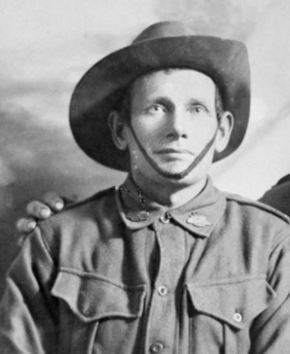
HAY, William
| Service Number: | 6752 |
|---|---|
| Enlisted: | 6 September 1916 |
| Last Rank: | Private |
| Last Unit: | 13th Infantry Battalion |
| Born: | Kiama, New South Wales, Australia, October 1877 |
| Home Town: | Beaumont, Shoalhaven Shire, New South Wales |
| Schooling: | Not yet discovered |
| Occupation: | Farm Labourer |
| Died: | Cerebro-Spinal Fever, France, 26 February 1917 |
| Cemetery: |
Etaples Military Cemetery XXI J 4 |
| Memorials: | Australian War Memorial Roll of Honour |
World War 1 Service
| 6 Sep 1916: | Enlisted AIF WW1, Private, 13th Infantry Battalion | |
|---|---|---|
| 8 Nov 1916: | Involvement Private, 6752, 13th Infantry Battalion, --- :embarkation_roll: roll_number: '11' embarkation_place: Sydney embarkation_ship: SS Port Nicholson embarkation_ship_number: '' public_note: '' | |
| 8 Nov 1916: | Embarked Private, 6752, 13th Infantry Battalion, SS Port Nicholson, Sydney | |
| 8 Nov 1916: | Embarked AIF WW1, Private, 6752 |
A cruel and unfitting end
William (Bill) Hay was born in October 1877 and as such was one of the oldest men to enlist from Kangaroo Valley NSW. The son of (late) William and Janet Hay of Beaumont he was then almost 39 years of age and working as a farm labourer.
Enlisting at Kiama on 10 July 1916 along with James Gordon he became part of the 22nd Reinforcement of the 13th Battalion.
Bill Hay and Oswald McClelland were enthusiastically farewelled by the Lodge of the 42 Loyal Orange Institution (LoI or Orange Order) on 12 October 1916. Hay was gifted a wristlet watch and kit bag.
The 13th Battalion then departed Sydney on the SS Port Nicholson on 8 November 1916. The Port Nicholson arrived at Davenport England on 10 January 1917 and into a Europe that was gripped by the worst winter for 40 years. The freezing temperatures and wet conditions were extremely harsh to these men accustomed to warmer climes.
Bill Hay was never to see action.
He was already ill when he crossed the English Channel, entering France at Etaples on 18 February 1917. On 23 February he was admitted to the 26th General Hospital there and was dangerously ill soon after. Bill Hay died at 4.15am on 26 February of cerebro-spinal fever (rheumatism) and pneumonia. Rheumatic fever is an inflammatory disease that can develop as a rare complication of an untreated strep throat infection. This can then cause damage to the heart, brain, joints and spinal cord.
William Hay died without ever seeing the enemy or entering a battlefield. He is buried in the Etaples Military Cemetery where 10792 Commonwealth soldiers lie.
[The author visited his gravesite in 2018]
A memorial service was held at the Kangaroo Valley Presbyterian Church on 19 August 1917 for William Hay, Jack Huxley and James Gordon. Huxley and Gordon had been killed at the Battle of Messines on 8 June 1917. All sections of the community attended. The railings were adorned with the Union Jack and the Australian flag. Captain Chaplain Jamieson conducted the service saying:
"Blessed are the peacemakers for they shall be called the children of God."
The way to peace, he said, was in this instance the way to war.
22 fallen men from the Valley would be so labelled as "peacemakers" before this war ended. This eloquent service ended in the National Anthem. Mr. Kebby presided on the organ.
Photographs of Bill's original gravesite were sent to his younger sister Jannett.
His mother Janet (now Bailey) received his two war medals, Memorial Scroll and Plaque in July 1922. She also received a parcel of his personal effects as were collected at the Etaples hospital. These included the wristlet watch gifted to him on his departure.
Ironically Bill's first cousin Trooper James Thomas Hay had met an eerily similar fate in the Boer War. James had enlisted and served with the Second NSW Mounted Rifles and died of pneumonia in Capetown on 12 October 1901, aged 19 years.
Submitted 31 December 2021 by Geoffrey Todd










